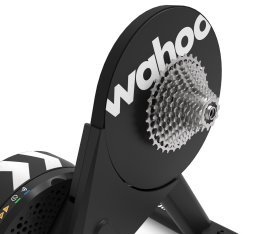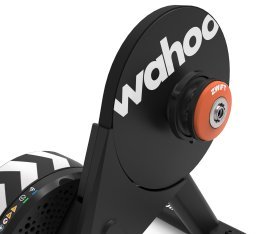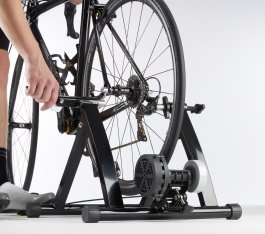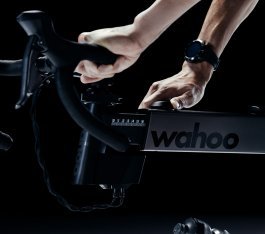
Tips against cold feet while cycling
Winter riding means cold feet? Not anymore! With our tips, you can banish freezing toes and enjoy every chilly ride.
What types of indoor trainers are out there, and which one suits you best? We give you an overview and present the best models on the market.
The days are getting shorter and the weather less inviting – perfect conditions for a training session on the indoor trainer.
Instead of riding in the dark, rain, or mud (and spending hours cleaning your bike afterwards), an indoor trainer offers you an effective and fun alternative. In the past, you might have relied on music or movies to stay motivated while riding indoors, but today there’s much more: smart technology brings virtual group rides, famous Alpine climbs, and structured, personalized workouts straight into your living room. In this article, we’ll show you the different types of indoor trainer systems and help you find the one that best fits your goals.
Indoor trainers can be categorized according to different criteria. In this article, we’ll distinguish between trainer types based on how resistance is controlled and how the bike connects to the training device:
Very important: Always make sure your bike is compatible! Frame, axle system, and drivetrain must match the trainer, and your bike should be approved by the manufacturer for use on an indoor trainer.
If you want to dive into the world of online training platforms like Zwift and others, there’s no way around a smart trainer. Smart trainers are interactive – meaning the sensors built into the trainer record all your ride data and send it to your training app. In return, the app can control the trainer’s resistance. This two-way communication is essential to simulate real riding conditions — for example, increasing resistance when the virtual road goes uphill – and to place you in the digital peloton according to your performance, reducing resistance again when you reach the summit.
Smart trainers exist across all trainer types – they’re less common among wheel-on and roller trainers, but much more prevalent in the direct-drive category. That’s no coincidence: these trainers are the most accurate and come equipped with the most advanced sensors by default.
Did you know? Some manufacturers differentiate between “smart” and “interactive” trainers. “Smart” trainers only collect and transmit data to a device, while “interactive” trainers allow two-way communication for realistic terrain simulation – as seen on popular online training platforms. When we talk about smart trainers (as do most manufacturers), we mean the fully interactive kind.
The term smart trainer doesn’t refer to one specific design – it describes any device capable of transporting you into virtual training worlds! © Wahoo

With direct-drive trainers, you can choose between real shifting on a traditional cassette or … © Wahoo

… or virtual shifting with a Zwift Cog and Click. © Wahoo
With a direct-drive trainer, the rear triangle of your bike is mounted directly onto the trainer – meaning your rear wheel has to come off. The chain of your bike runs on the cassette attached to the trainer, so your frame must be compatible with the unit, and the trainer’s cassette must match your drivetrain. Direct-drive trainers typically come with all the necessary sensors to measure your performance precisely. They’re also the quietest trainers on the market, offer excellent stability (even during all-out sprints), and connect easily to your PC, Mac, tablet, or smartphone. In terms of price, they sit in the mid- to high-end range. The resistance they can generate is high enough for even the toughest sprint intervals – and since power is transmitted directly via the trainer’s cassette, you don’t have to worry about a slipping rear wheel like on traditional wheel-on trainers.
Quieter, more precise, and usually smart: direct-drive trainers require more effort to set up, but offer greater comfort during training. © Wahoo
| Pros | Cons |
|---|---|
| Extremely quiet – ideal for apartments | Higher price |
| Precise power measurement (+/- 1–2%) | Longer setup and takedown time (rear wheel must be removed) |
| No tire wear or slipping | Heavier and less portable |
| Very realistic ride feel thanks to heavy or virtual flywheels |
Direct drive is perfect for you if you want to train with structure, take part in virtual races, and experience the most realistic ride feel possible.

The 3min19sec roller trainer is a great entry into indoor training and especially practical if you want to switch your bike quickly and flexibly between outdoor and indoor use. © bc GmbH
With a wheel-on trainer, your rear wheel stays on the bike – that’s why they’re also called “wheel-on” trainers. The bike is clamped into the trainer via the quick release skewer or thru-axle, while a resistance unit presses against the tyre. During use, heat and friction build up between the tire and the resistance unit, which leads to faster tire wear. That’s why we recommend using a harder, dedicated trainer tire designed specifically for indoor use. However, you shouldn’t ride it outdoors for safety and grip reasons. Wheel-on trainers are relatively lightweight, can usually be folded quickly, and are therefore easier to transport than direct-drive models. They’re also much more affordable, making them a great entry point into indoor cycling. The downside is that they are significantly louder under high load. Not just the volume, but especially the vibrations at higher speeds can annoy neighbours or family members. If you plan to do hard sprints or steep hill simulations, pay attention to the trainer’s maximum braking power and resistance levels! Connecting to a PC or tablet for training monitoring is typically straightforward, and some wheel-on trainers are even available as smart versions.
| Pros | Cons |
|---|---|
| More affordable to purchase | Louder than direct-drive trainers |
| Quick setup and takedown since the bike is simply clamped in | Tire wear (a dedicated trainer tire is recommended) |
| Lightweight and easy to store | Less accurate power measurement |
A wheel-on trainer is the right choice for you if you want to ride occasionally during the winter, keep your budget in check, and need a setup that’s quick and easy to store.
An alternative – though less common since the rise of smart trainers – is the set of free rollers. In this setup, the bike isn’t clamped in but instead rests freely (hence the name) on three rollers: one for the front wheel and two for the rear, with the front roller connected to one of the rear rollers by a belt. This means both wheels rotate as you pedal, and you have to maintain your own balance. The roller or guide construction makes it difficult to ride off the rollers, but it can still happen – so it’s best to set up your rollers in a doorway at first. That way, you can easily grab something for support if you lose your balance.
Most free rollers don’t have a built-in resistance unit, so the resistance is quite low and not ideal for intense interval training – though there are some well-equipped exceptions. Even with those, you’ll typically need an external power meter on your bike to record your performance data. Nowadays, free rollers are mostly used by professionals or ambitious amateurs, since they’re great for warming up before a race: you can spin at high cadence and get your legs “awake.”
Free rollers are often used by pros for warming up. They stand out for their compact size and instant readiness — though riding them smoothly takes a bit of practice. © Elite/Shimano
| Pros | Cons |
|---|---|
| Trains balance, coordination, and core stability | Requires practice and concentration |
| Very realistic, dynamic riding feel | Usually no or only low resistance |
| Perfect for warming up before races | Power measurement only possible via an external power meter |
A special type of free roller, the Feedback Omnium Over-Drive features progressive resistance that increases with wheel speed. © Feedback Sports
Free rollers are awesome if you want to improve your balance or warm up efficiently before races.

Everything adjustable: With a smart bike, you can configure the entire frame geometry to your personal preferences. © Wahoo
Traditional ergometers are rarely found in performance-oriented cycling any more – but those equipped with intelligent resistance control certainly are. These are known as ergometers and represent the pinnacle of indoor cycling. Smart bikes are standalone devices, meaning you don’t need to disassemble or mount your bicycle – they’re always ready to ride. They operate very quietly, offer excellent stability, and come equipped with an integrated power meter and all the necessary sensors to precisely track your training and connect seamlessly to online training platforms. Smart bikes are relatively heavy and require more space, as they can’t be disassembled for compact storage during the summer months. They also represent the premium price segment among the systems presented here.
Smart bikes or high-end ergometers are the ultimate level of indoor training — but they also take up the most space when you’re not using them. © Wahoo
| Pros | Cons |
|---|---|
| Always ready to use – no need to mount your own bike | High price |
| Extremely quiet and stable | Heavy and requires a permanent setup space |
| Perfectly adjustable for multiple users | |
| Features like gradient simulation and virtual shifting |
A smart bike is perfect for you if you’re looking for maximum comfort, don’t want to mount and dismount your bike all the time, and see indoor training as a key part of your athletic routine.
Already decided on your preferred type of trainer? Perfect! Now let’s dive into the details and guide you through the jungle of available technologies. Our comparison table gives you the perfect overview to get started:
| Model | Type | Max. Power | Max. Gradient | Power Accuracy | Special Features | Price Range |
|---|---|---|---|---|---|---|
| Garmin Tacx Neo 3M | Direct Drive | 2,200 W | 25 % | < 1 % | Multi-directional bike movement, virtual flywheel | €€€€ |
| Garmin Tacx Neo 2T | Direct Drive | 2,200 W | 25 % | < 1 % | Virtual flywheel | €€€ |
| Wahoo KICKR Move | Direct Drive | 2,200 W | 20 % | ± 1 % | Slight lateral and stronger fore/aft movement | €€€–€€€€ |
| Wahoo KICKR V6 | Direct Drive | 2,200 W | 20 % | ± 1 % | Slight lateral bike movement | €€€ |
| Elite Justo 2 | Direct Drive | 2,300 W | 24 % | ± 1 % | Light multi-directional bike movement | €€€ |
| Garmin Tacx Flux S | Direct Drive | 1,500 W | 10 % | 3 % | – | €€€ |
| Elite Avanti | Direct Drive | 2,100 W | 18 % | ± 1 % | Light multi-directional bike movement | €€€ |
| Elite Rivo | Direct Drive | 2,000 W | 18 % | ± 2 % | Light multi-directional bike movement | €€–€€€ |
| Wahoo KICKR Core 2 | Direct Drive | 1,800 W | 16 % | ± 2 % | – | €€–€€€ |
| 3min 19sec Premium Bike | Wheel-On | 500 W | – | – | 7 resistance levels | €€ |
| Elite Qubo Power Smart B+ | Wheel-On | 900 W | – | ± 5 % | 8 resistance levels | €€ |
| Garmin Tacx Galaxia | Roller Trainer | – | – | – | Fore/aft movement | €€ |
| Elite Arion Mag | Roller Trainer | 805 W | – | – | 3 resistance levels | €€ |
| Wahoo KICKR ROLLR | Semi Roller Trainer | 1,500 W | – | – | Front wheel fixed | €€–€€€ |
| Feedback Sports Omnium Over-Drive | Semi Roller Trainer | – | – | – | Front wheel fixed, magnetic brake with automatic resistance increase | €€–€€€ |
| Wahoo KICKR BIKE PRO | Smart Bike | 2,500 W | 20 % | ± 1 % | Programmable virtual shifting, gradient simulation | €€€€€ |
| Wahoo KICKR BIKE SHIFT | Smart Bike | 2,200 W | 20 % | ± 1 % | Programmable virtual shifting | €€€€€ |
Simply put: the more expensive the indoor trainer, the more accurate its power measurement usually is, and the higher the maximum resistance and simulated gradients. However, that often means it’s also heavier. Some trainers now come with a Zwift Cog and Click upgrade kit, which includes a cog and a remote control. This setup eliminates the need for a cassette, allowing you to shift gears virtually.
The Wahoo KICKR Move is Wahoo’s top-of-the-line trainer. Its dual-axis construction provides an exceptionally realistic riding experience: in addition to slight lateral movement, your mounted bike can move up to 20 centimeters forward and backward. The Wahoo KICKR V6 offers nearly the same premium features – minus the front-and-back motion – making it a great alternative if you’re not ready to go all-in just yet.
Both the Garmin Tacx Neo 3M and its predecessor, the Garmin Tacx Neo 2T, are regarded as two of the best trainer systems on the market, but they also sit at the top of the price range. They feature a virtual flywheel that delivers highly realistic inertia and a smooth, lifelike ride feel. The virtual flywheel also helps reduce noise and vibration. The Neo 3M includes integrated (and optionally deactivatable) motion plates for enhanced comfort and realism, while the more affordable Neo 2T allows you to add them later.
For those looking to enter the world of direct-drive smart trainers, the Elite Rivo and Wahoo KICKR Core 2 are excellent options. While they can’t quite match the top models in terms of noise level or resistance, they offer a great balance of performance and price.
Wheel-on trainers mainly differ in their braking systems and whether or not they require an external power source. Entry-level models like the Premium Bike trainer from 3min19sec use a mechanical magnetic brake. The resistance is adjusted manually via a lever on the handlebar, and the trainer operates completely without electricity. This makes it particularly simple and versatile to use. If you’re looking for a similar setup but with more braking power and the ability to record your training data directly, the Elite Qubo Power Smart B+ is the trainer to go for.
When it comes to free rollers, the range spans from very simple models to those equipped with swing systems that move forward and backward during acceleration and braking, and even advanced rollers with resistance control and gradient simulation.
The Garmin Tacx Galaxia is an unbraked free roller trainer that closely replicates the feeling of riding on the road. Thanks to its patented swing system, the trainer moves forward when you accelerate and backward when you brake. This design allows you to sprint without accidentally rolling off. If you’re looking for a free roller with some resistance control, the Arion Mag by Elite is a solid choice. It features a three-level magnetic resistance system that lets you adjust the braking intensity. If you want a model with more stability and higher-end features, the Wahoo KICKR ROLLR is a great option. Technically, it’s only half a free roller: the front wheel rests on two small supports and is held laterally in place, while the rear wheel spins on two narrow rollers. This design ensures stability and lets you fully focus on pedalling. Additionally, the KICKR ROLLR offers adjustable resistance and gradient simulation. If you equip it – or your bike – with a power meter, you can even connect it to training apps like Zwift and others.
In our shop, you’ll find the crème de la crème of smartbikes: the Wahoo KICKR Bike Shift and the Wahoo KICKR Bike Pro. These bikes are purpose-built for indoor use and equipped with highly accurate power meters to deliver the most realistic virtual training experience possible with Zwift and similar platforms. Their shifting systems are virtual and fully customizable, allowing you to replicate the gear setup and feel of your real bike. The smart Wahoo bikes can also be easily adjusted for multiple riders. Adjusting the saddle and handlebar is quick and intuitive, and the Wahoo app guides you through the setup process. This makes it easy to perfectly mirror the position of your outdoor bike. The Wahoo KICKR Bike Pro takes it a step further with an incline simulation feature that mimics climbs and descents by physically tilting the bike. This makes virtual training even more immersive – and your back and hands will thank you as the pressure on your body shifts naturally throughout your ride.
Have you decided on your new trainer? Great! Now you just need to choose whether to invest right away or spread out the cost. With us, you have both options!
The cassette you require for your direct-drive smart trainer depends on your bike’s drivetrain. The cassette must be compatible with your rear derailleur (manufacturer, number of gears) and your chain. Also, make sure to use the correct freehub body for your direct-drive trainer! Many trainers come with both a Shimano and a SRAM XD freehub body included; SRAM XDR or Campagnolo freehub bodies are available separately.
Depending on your bike’s axle system, you may need adapters or spacers. Check the contents of your desired trainer’s box – often everything you require is already included. If not, adapters and spacers are usually available separately. Also, make sure your bike manufacturer has approved your frame for use with a direct-drive trainer!
Direct-drive trainers are significantly quieter than wheel-on trainers, since there’s no tire friction and fewer vibrations. To minimize noise for your neighbours, use a damping mat under both types of trainers, and for wheel-on trainers, consider a dedicated trainer tire!
We recommend using a special trainer tire for wheel-on trainers. These are quieter, more durable, and heat-resistant. However, you shouldn’t use them outdoors since they generally offer much less grip than your regular tires.
For the best experience, select a compatible smart trainer that communicates bidirectionally with the training platform: it measures your performance and sends it to the app, while also allowing the app to control the resistance. Some manufacturers refer to this as an *interactive* trainer. Direct-drive trainers are typically the best choice for virtual indoor cycling, since they usually come equipped with all the necessary sensors.